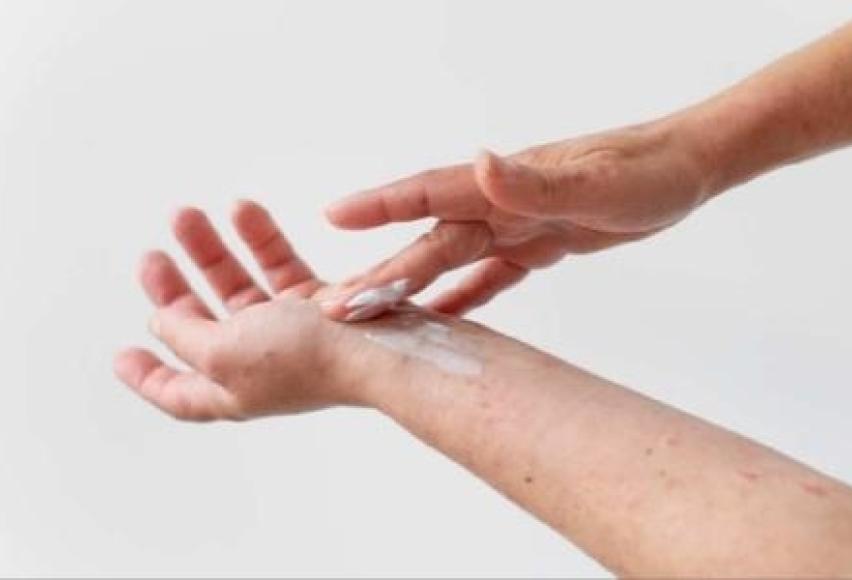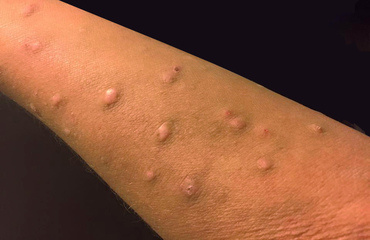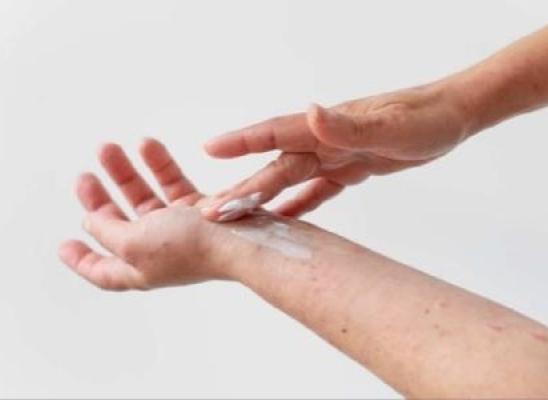Nodular Prurigo vs Dermatillomania

Online test
Find out the severity of your symptoms with this free online test
While it can be easy to confuse the two based solely on physical appearance, there are several key differences when considering the conditions of nodular prurigo and dermatillomania. Both can be very painful, even debilitating conditions, but it's important to note the similarities as well as differences between the two, as a misdiagnosis could waste precious time and money, as well as prolong unnecessary pain. As a result, in this post we're going to look at a description of both conditions, as well as applicable symptoms and possible treatments and outline some of the basic similarities and differences between the two conditions. First let's start off with nodular prurigo and check out what some of the clinical features of that condition are.
Nodular Prurigo: Clinical Features
Nodular prurigo is basically a skin condition that presents with very itchy, firm bumps on the skin. It's in fact the most severe form of prurigo, though it's still not known why these bothersome lumps actually appear in the first place. Unfortunately, this condition is quite difficult to treat in an effective way. Even so, it's important to recognize some of the clinical features so that we can distinguish this from dermatillomania and you or a loved one can get the help that they need. While nodular prurigo can appear in anyone at any age, it's most common that it'll appear in people aged 20-60, and both sexes are equally affected by this condition. What this condition is is basically a firm lump that can range from one to three centimeters, and it'll appear with a raised surface that might have some resemblance to a common wart. Early on, the lump might start as a small and itchy red lump, and then progress to crusting and even scaling if and when the sufferer decides to scratch the lump or lumps. You can distinguish older lumps by their paler look, and the way they'll tend to blend in with the rest of the skin. Unfortunately, as is often the case with conditions like this, the itching sensation can be quite intense and last for hours, which will counterintuitively worsen the condition once the sufferer does give in and go ahead and scratch. The strange thing about nodular prurigo is just how widespread it can appear throughout the body, with the body, face, and even the palms of your hands being viable places for these harmful bumps to develop and grow. And also, since these lumps do tend to take quite a while to run their course, there can be a great deal of stress involved, even depression in more severe circumstances. So now that we've gotten a handle on some of the clinical features of nodular prurigo, let's take a look at some of the established causes of the condition so we can get a better look at how it ultimately differs from dermatillomania.
Nodular Prurigo: Causes
Unfortunately, the exact cause of nodular prurigo is not known at this time. Experts haven't been able to solve this particular chicken and egg situation: whether the scratching leads to the lumps, or the lumps lead to scratching. The reason for all of these things is being investigated, but is not entirely known at this time. It is important to note, however, that up to 80% of patients who suffer from this condition have a family history of atopic dermatitis, hay fever, or asthma, and that's in comparison to about 25% of the general population on the whole. Nodular prurigo can start as the result of an insect bite or as a secondary form of dermatitis. The condition has been associated with iron deficiency (also known as anemia), as well as HIV infection and a variety of other conditions. There are a few other conditions that are associated with nodular prurigo, but none of these connections has proven to be conclusive at finding the exact cause of this painful condition. Let's now go ahead and take a look at the ways that this condition is diagnosed.
Nodular Prurigo: Diagnosis
Oftentimes, a skin biopsy will be necessary to confirm the diagnosis of nodular prurigo. Once the skin is examined under the microscope, it'll look fairly abnormal and thickened, and might even share some visual similarities with what you'll see in skin cancer. The skin will be quite inflamed, and as a result there will be plenty of itch receptors that will be more active than normal, which itching will of course only lead to an overall worsening of symptoms.
Nodular Prurigo: Treatment
While this is a fairly treatment resistant condition, there are several options that you have at your disposal to help treat the lumps that you or a loved one may be experiencing. This involves emollients, oral antihistamines, corticosteroid injections, coal tar ointment, and even cryotherapy, which will decrease the overall size of the skin lumps and may even help with the itching sensation that you might feel. Again, while this is a treatment resistant condition that doesn't have any definite causes listed, it is entirely possible that some of the symptoms can be reduced through the proper treatment. In addition there are also support groups for people who suffer with condition to seek information, advice, tips and support and is supported by the Nodular Prurigo International Network. So now that we've gotten a highly detailed look at the description, causes, diagnosis, and even treatment of nodular prurigo, we can go ahead and explore what dermatillomania is so that key similarities and differences can be made between the two.
Dermatillomania: Everything You Need to Know
While many might not consider skin picking to even be its own condition let alone a real problem, it is a painful, even dangerous condition that shares some physical characteristics in common with nodular prurigo. Symptoms for this condition may include excessive rubbing, scratching, picking, and even digging into the skin itself. This can result in lumps that are quite similar in appearance to what you might find in nodular prurigo, but can even be the cause of some severe tissue damage if the case is particularly severe and the damage is left untreated over time. This is considered a ritualistic, obsessive disorder that centers around the sufferer repeatedly damaging their skin as a way of coping with potentially harmful, obsessive thoughts. This disorder is classified as a BFRB (Body-Focused Repetitive Behavior), and is similar to conditions such as trichotillomania (hair-pulling) in just how insatiable the urge to pick can be for a sufferer. While it is still commonly referred to as dermatillomania, the official clinical term for is excoriation disorder. So, while nodular prurigo and dermatillomania are both similar in the outward physical appearance of the injuries sustained, dermatillomania is in fact a compulsive behavior, whereas the scratching that comes along with nodular prurigo is more related to the itching sensation that comes along with the condition. According to the the Diagnostic and Statistical Manual, diagnosis of excoriation disorder must include the following characteristics:
- Recurrent skin picking resulting in skin lesions
- Repeated attempts to decrease or stop skin picking
- The skin picking causes clinically significant distress or impairment in social, occupation, or other important areas of functioning
- The skin picking is not attributable to the psychological effects of a substance (e.g., cocaine) or another medical condition (e.g., scabies)
- The skin picking is not better explained by symptoms of another mental disorder (e.g., delusions or tactile hallucinations in a psychotic disorder, attempts to improve a perceived defect or flaw in appearance in body-dysmorphic disorder, stereotypes in stereotypic movement disorder, or intention to harm oneself in non-suicidal self-injury)
Source
Online test
Find out the severity of your symptoms with this free online test
Start your journey with SkinPick
Take control of your life and find freedom from skin picking through professional therapy and evidence-based behavioral techniques.
Start Now



